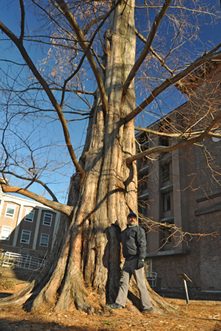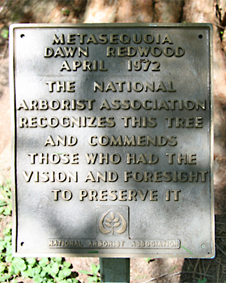|
Campus Visitor Aspires to Duplicate College’s
Unusual Tree with Donated Seeds
| |
 |
| |
Michael Marcotrigiano, Botanic Garden director, with Smith's Dawn Redwood |
 |
 |
NORTHAMPTON, Mass. - Having spent several decades examining a certain species of tree across five nations, Walter Rippberger was familiar with the deep furrows, cavities and rough bark that characterized its trunks.
So when the 60-year-old German botanist arrived at the Smith College Botanic Garden in the fall, he was surprised by what he discovered behind Neilson Library: a towering specimen of the Metasequoia
glyptostroboides, except without those dramatic qualities he knew the tree by.
Among all the
Metasequoias—commonly referred to as the Dawn Redwood—that Rippberger has examined, in Germany, France, England, Canada and the United States, only the Smith tree lacked the deeply furrowed trunk and had a smoother bark without cavities, he said.
“What is it with this tree?” Rippberger asks.
To try to answer his own question, Rippberger is attempting to reproduce Smith’s tree from seeds donated to him by the Botanic Garden, just as Smith’s Botanic Garden germinated its tree more than 60 years ago from seeds originating in China.
Until the 1940s, when a living population of Dawn Redwoods was discovered in China, the tree was known only from fossil records, said Michael Marcotrigiano, Botanic Garden director. The seed for the tree behind Neilson Library was collected in the wild and shared with the college by Harvard University’s Arnold Arboretum.
The fact that Smith maintained a detailed record of the lineage of its tree is not unusual. Most
arboreta, botanic gardens and serious collectors want to know the lineage of their specimens, said Marcotrigiano. The Smith collection contains plants that have strong documentation, which is why the seeds are sought out.
Sixty years ago, when the Arnold Arboretum donated the seeds to Smith, it also did so with other Botanic Gardens around the world, according to Rippberger. However, all of the other seeds grew into trees that developed the characteristics of deep furrows, cavities and rough bark. “Only the 1948er Smith College tree is different,” he said.
 |
|
| "The National Arborist Association recognizes this tree and commends those who had the vision and foresight to preserve it." It is dated 1972, the year the tree was relocated on campus to its current spot. |
|
 |
 |
Even at Smith, the Dawn Redwood behind the library is unusual, according to Marcotrigiano.
All of the college’s Dawn Redwood trees are seedlings of the tree behind Neilson, yet so far all have the species’ typical dramatic characteristics. “This ‘mother tree’ remains unique,” Marcotrigiano explained.
Marcotrigiano considers the unusual characteristics of this tree similar to unusual characteristics that are represented in any species. Among humans, “uniqueness” may take the form of such characteristics as height or intellect, whereas with plants it may take the form of an unusual bark.
“What we are likely seeing is a ‘less than usual’ member of the larger population, like a
Michael Phelps or Madame Curie—just something not as typical when compared to the rest of the population.”
In late December, Rippberger received about a teaspoon of the “mother tree’s” seeds in the mail from the Botanic Garden. He hopes to plant one of the seedlings in his own arboretum on land in a hilly region of southern Germany “not very different from Massachusetts or the parts of Maine that I have seen.”
The opportunity is one that could easily have been missed. A visit to Smith wasn’t even originally among Rippberger’s New England itinery. The Arnold Arboretum in Boston and the Blithewold Arboretum in Bristol, R.I., were his main destinations.
“We chose Smith College Botanic Garden because somehow the website appealed to us," said Rippberger. Now "I will certainly mention Smith College as often as I can—you more than deserve it.”
“This will be the best and our most cherished Christmas present this year.”
|























